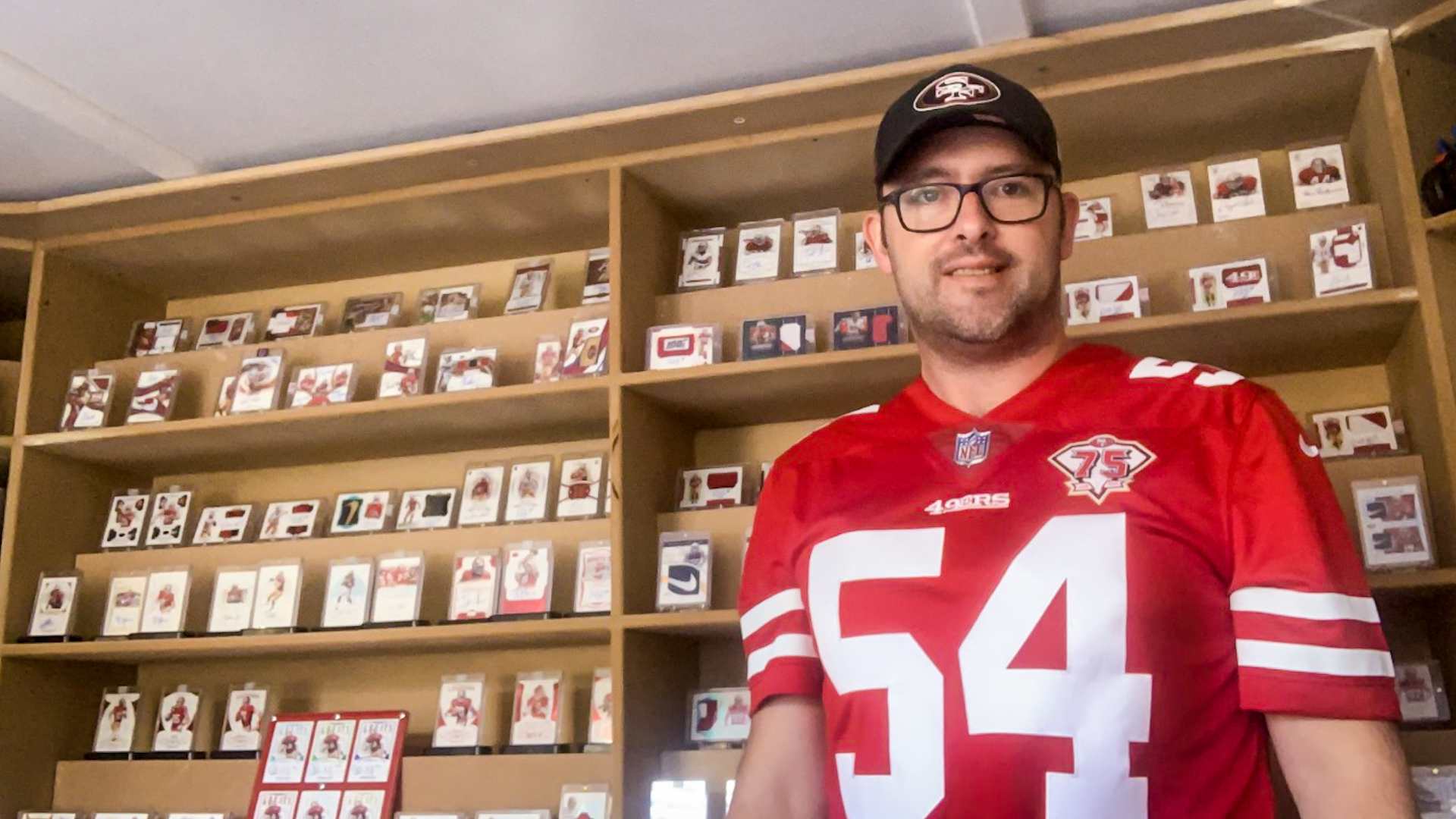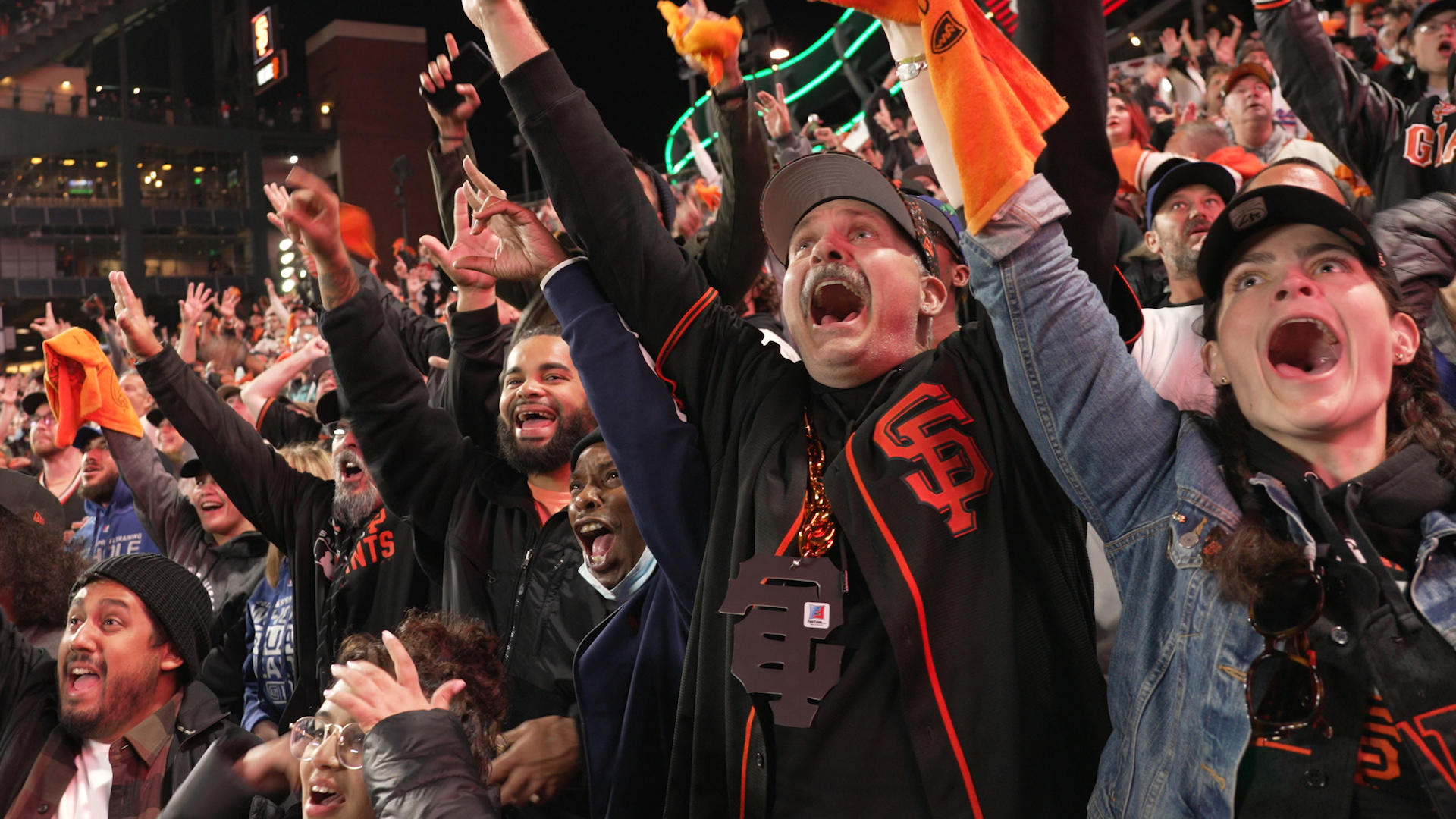What to Know
- Mason Alan Dinehart, 85, who now lives in San Ramon, is best known for his appearances on the TV Western series "The Life and Legend of Wyatt Earp" during the 1950s
- In 1984, Dinehart discovered the hobby of Olympic pin trading, and became a prolific collector of all things related to the Games — especially gold medals and the colorful official pins of national teams
- Dinehart now works as an expert witness, testifying on behalf of defrauded investors against crooked brokers including Bernie Madoff
His film credits include movies with the likes of Clark Gable and John Wayne, but when Mason Dinehart introduces himself these days, he rarely leads with his acting career.
"I'm a collector of Olympic pins, first and foremost," he said when we sat down. "It's the only hobby I've ever had."
Indeed, the walls of his cozy home office in San Ramon aren't lined with autographed movie posters. Instead, his desk is covered in gleaming, colorful pins from countries around the world, many of them dating back to 1936, the year he was born.
Get a weekly recap of the latest San Francisco Bay Area housing news. Sign up for NBC Bay Area’s Housing Deconstructed newsletter.
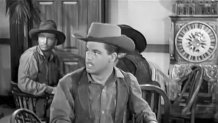
The son of two actors, Dinehart came into the world at the dawn of the modern film era, when sound and color were both relatively new. He started acting at a young age, in Roy Rogers' "Eyes of Texas" — a 1948 movie that was filmed in Technicolor, but only survives today in black and white.
That same year, Dinehart earned a prestigious distinction:
"I was the first actor ever to play Superman on film," he said. "I played Clark Kent as a boy."
It was Columbia Pictures' Superman serial, the first live-action portrayal of the Man of Steel on the big screen. It was a low-budget affair with hand-drawn animations for special effects, and Dinehart appeared in the first of its fifteen chapters.
"My job, with my X-ray vision, was to dive into a haystack and pull out my mother's ring," Dinehart recalled.
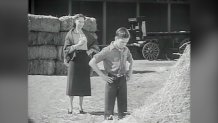
Though it was an uncredited, non-speaking role, it gave Dinehart a taste for Hollywood — and perhaps a taste of the joy he'd find later in life, searching in a proverbial haystack for small, shining gems of Olympic history.
As he got older, Dinehart found steady work appearing in Westerns and other adventure movies.
"It was just luxurious, as a young man growing up," he said. "I got to meet all the wonderful, wonderful actors — the Charles Coburns, the Edward Arnolds, the Clark Gables, the John Waynes."
He hit his stride at just 19 years old when he landed a recurring role as Bat Masterson in "The Life and Legend of Wyatt Earp." It was TV's first Western series aimed at adults, and is still syndicated today by Proven Entertainment, which provided us clips for use in this story.
Dinehart's character was a gunslinging, gambling sidekick to U.S. Marshal Wyatt Earp, flirting with well-dressed women and frequenting saloons, even though in real life, he was still too young to legally order a drink in California. In Dinehart's first big episode, Earp (played by Hugh O'Brien) even makes a joke about his unsuccessful attempt to grow a mustache.
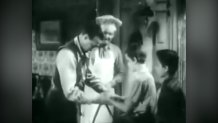
Dinehart appeared on the show during five of its six seasons, but once it concluded, he said he'd begun to realize he had a passion outside the world of show business. He'd taken a job as a bank teller while he was still acting, and had started to climb up the corporate ladder at Bank of America.
"It came to a point where I said I need to go into the career that I really want — and that would be in the brokerage industry," he said.
He learned everything he could about real estate transactions, trading stocks and trading bonds, but there was one kind of trading he hadn't discovered yet. When the Olympics came to Los Angeles in 1984, Dinehart found himself immersed in a brand new world: Olympic pin trading.
"It was an auction to get tickets, and I got the track and field, so I went to the Coliseum," he recalled. "There may have been 35 to 40,000 people in the stands; there were 25 to 30,000 people outside on the lawns around the Coliseum, trading Olympic pins. And I said, 'What in the world is this?'"
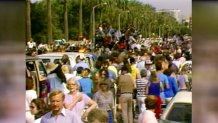
Dinehart had stumbled upon what's known to frequent Olympic spectators as the "unofficial Olympic sport." Olympic pins have existed since the very first summer games in Athens in 1896, and by some accounts, the practice of trading them became common among athletes during the 1924 Olympics as a show of friendship between competitors from different countries.
Today, it's common to find athletes, officials, volunteers and journalists wearing lanyards lined with shiny pins, and stopping to make trades in common areas around the Olympic venues.
"When you conclude a trade with someone, you shake hands: you've made a friend," said Sid Marantz, vice president of Olympin, the world's largest Olympic pin trading club.
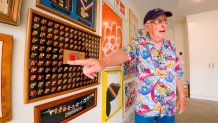
Marantz said he and his wife first took up the hobby when they attended the 1976 Olympics in Montreal. Though it had long been common among those competing or working at the games, he said that was the year pin trading really caught on among spectators.
"I enjoy the trading just as much as I do the having," he said. "Because you trade memories, you collect memories. I've traded pins with Prince Albert of Monaco, with Mary Lou Retton, with gold medalists, with heads of state, and just with normal little kids. It's a hobby without class distinction."
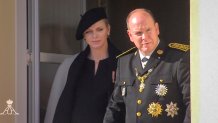
To Dinehart, it represents the Olympic spirit in its purest form. And for the first time since his earliest days in the movies, he found himself starstruck.
"The athletes would actually come out in their uniforms, and they had their NOC or (National) Olympic Committee pins, and they would want to trade with you," Dinehart said. "So you got to know the athletes from these countries."
1984 was a banner year for pin trading at the Olympics, and the LA summer games that year remain the reason why much of the American pin trading community is centered in Southern California to this day. Though there are pins from sponsors, from TV networks, and even from the Olympic mascot (Sam the Eagle that year), Dinehart found himself immediately drawn to "country pins" — the official pins of each National Olympic Committee that spectators often get by trading directly with the athletes.
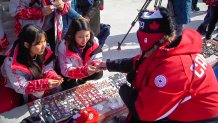
"They're more colorful," he said. "They're much more striking."
And by a coincidence of history, the most colorful and striking assortment of NOC pins ever produced came from the 1936 Olympics: the year Dinehart was born.
"They're much larger than the normal Olympic pins that you see, and they were just really crafted exquisitely," he said.
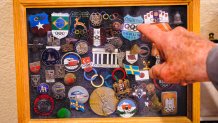
Berlin hosted the Olympics in 1936. It was Germany's chance to be on the world's stage again after its defeat in World War I. The beginnings of the Second World War were already brewing, with the Nazi party in power and Adolf Hitler at its helm.
After the German government ordered the exclusion of Jewish athletes from Germany's national Olympic team, other countries considered boycotting the games. But ultimately, they elected to show their own national pride in the face of Hitler's propaganda machine, with the biggest and most ornate Olympic pins ever made. Some of those pins are now worth thousands of dollars apiece — and Dinehart has two display cases full of them.
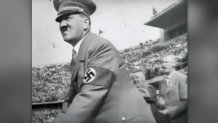
1936 was also the year of the very first Olympic torch relay, with runners carrying the Olympic flame from Athens all the way to Berlin, where a single athlete lit the cauldron during the opening ceremony. Dinehart has a torch from that relay — a gleaming, silver object the size of a lamp, covered in fine engraving.
"The torch for 1936," he proclaimed as he presented it. "Made by Krupp Steel."
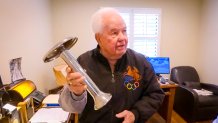
Krupp Steel later went on to manufacture tanks and guns for Germany's military during World War II — a stark contrast to the peace and unity symbolized by the shining steel torches that were made from the same metal.
The 1936 Olympics brought one more piece of noteworthy memorabilia: the largest Olympic medals ever made. They actually come from that year's winter games, which were held in the German ski resort town of Garmisch-Partenkirchen. Dinehart has a bronze medal that was awarded in pairs figure skating that year, and it's nearly the size of a tea saucer.
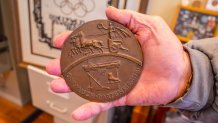
"The winners' medals are the prize collection," Dinehart explained. "Especially those that are awarded to an athlete, where you have the diploma to prove that it was actually awarded in a key sport in the Olympics. Rowing wouldn't be as attractive or valuable as, say, a track medal or a gymnastics medal."
Much like a fine Swiss watch comes with papers to prove its authenticity, an Olympic medal comes with a diploma — a large certificate that can be several feet long when unrolled. Dinehart has one framed in his office. And at one point, he had amassed a collection that included a gold medal from every summer Olympic games.
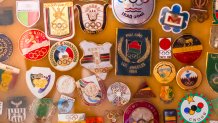
"When I turned 80 years old, we were going to move to San Ramon, California, from Los Angeles and buy a big house with a pool," he said. "So, I put them all up for auction, and except for a very few, which I still retain, I sold my medal collection."
According to sports memorabilia specialist Heritage Auctions, an Olympic gold medal can sell for $20,000 to $50,000. With more than two dozen of them in the collection he sold, it's no wonder Dinehart's new house is spacious, well-appointed, and filled with sunlight.
These days, Dinehart works as an expert witness in securities fraud cases, testifying on behalf of investors swindled by crooked brokers. His victories include three cases representing victims of Bernie Madoff, the disgraced mastermind of the biggest Ponzi scheme in history. The work draws on his decades of experience in finance, but also on his years as an actor.
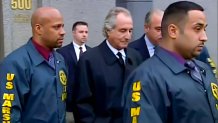
"When you walk into a courtroom, in front of a jury," he said with a smile, "You're on stage every minute!"
Fortunately, he said, the sort of trickery he battles in his professional life doesn't exist in the world of Olympic pin trading.
"People are totally honest," he said. "They don't come up with fakes. They tell you what something is worth."
Dinehart said he continues to trade pins at conventions all over the country, where he sees old friends and makes new ones. It's a lot different from the days of his Hollywood youth, he said, when friendships began and ended quickly, and often lasted only until the end of a production.
"People that come to those conventions are down home, real people," he said. "I didn't find that kind of person in show business."

Of course, in the hierarchy of important events for the hobby, the Olympics of pin trading are, quite literally, the Olympics. Dinehart and Marantz had both been hoping to attend the games in Tokyo. When it was announced that the Olympics would be held without spectators due to the ongoing COVID-19 pandemic, it put a damper on the games — and on pin trading there.
"Most of the trading took place only among the athletes, in the athletes' village," Marantz said.
Now, for the second time, American fans won't be traveling to see the games in person. The organizers of the 2022 Winter Olympics in Beijing announced in September that no spectators from outside mainland China would be allowed at the games.
Still, if Tokyo is any indication, pins traded among athletes and those working at the games will make their way across the Pacific to American collectors in the weeks and months following the Olympics. To get some of his own, Dinehart only needs to muster the patience and tenacity to do what he did at 11 years old — and go find them in a haystack.

